|
The Economic
Significance--Crops and Forestry
Termites do not confine their attention to dead plant tissues such
as wood. In many parts of the world, species of termites are serious
pests of growing crops including living trees. It is thought that
termites are seldom primary pests, only damaging the plant, shrub
or tree when it has already been affected by fire, a fungus or an
insect of another order. For instance, once another insect has bored
into a stock of a vine, the termite reproductives will enter fight
holes of that insect and start a colony which results in the stock
finally splitting. The fact that termites usually appear to be secondary
pests does not make them of less importance. The initial defect
affecting the plant is often of minor importance, but after allowing
ingress to termites the effect may be the complete destruction of
the plant or, at least, a reduction in its value as a crop (Hickin,
1971)
Cultivated plants in those areas of the world where termites occur
can be divided into four groups: plantation crops--generally, these
are woody perennials; field crops--generally, these are herbaceous
annuals; young trees--in nurseries and plantations; older trees--mainly
in forests, but including amenity trees.
The cacao plantation crop has been reportedly
under attacked by termites in the Gulf of Guinea, Ghana, the Ivory
Coast, Nigeria, New Guinea, Samoa, New Britain, and West Africa.
In Zanzibar, termites have attacked the planted seedlings on clove
plantations. Coconut palms seedlings have been attacked by subterranean
termites, while the mature palms have been attacked by drywood termites.
Nigeria, Malaysia, Indonesia, India, Ceylon, and many coastal strips
of tropical countries have been affected. Coffee crops in the Congo,
India, Uganda, Brazil, and Surinam have reportedly been under attack
by termites. Arabia and Sudan have found termites in their date
palm crops. Africa, Malaysia, and Indonesia report termites in their
oil palm crops. Rubber trees in Malaysia, Indonesia, Vietnam, Ceylon,
Brazil, Guyana, Nigeria, and southern Texas report termite infestation.
Sugar cane has been under attack by termites in many tropical and
sub-tropical countries including but not exclusively found in Panama,
Jamaica, Leeward Islands, Venezuela, Cuba, Puerto Rico, Barbados,
Guyana, Guadeloupe, Kenya, Somalia, Mauritius, India, Pakistan,
Formosa, South China, Hawaii, and Australia. Tea bushes have been
reported under attack in China, Formosa, India, Ceylon and Malaysia.
Field crops that have been infested with termites
are cotton and groundnuts. The cotton plant in Sudan, East and Central
Africa, and Arabia all report termite activity. Surprisingly enough,
the states that produce cotton in the United States have not been
affected. In Sudan, Senegal, and East Africa termites have damaged
groundnuts crops.
Pasture crops that are infested with termites
are rice, wheat and maize. Japan, Formosa, and Nigeria report heavy
infestation in their rice crops. Northern India and upland northern
Tanzania report damage in their wheat crops. Southern Tanzania report
activity in their maize crops.
Young trees in nurseries and plantations in
the tropical and sub-tropical regions of the world where the rainfall
is low and conditions are of drought or near drought, termite attack
is most acute. A popular tree species for the termite is the eucalyptus.
Several townhouse developments have included eucalyptus in their
landscaping only tom have them become infested and in turn become
the source of infestations going into the buildings. Young trees
in forests and plantations are hard hit in tropical Africa, South
America, China, Ceylon, and India.
Termites are found in generally dry areas rather
than in wet areas in older trees. Damage to older trees in a natural
forest is generally slight in comparison to isolated ornamental
trees. Older eucalyptus are heavily attacked in tropical Africa
and east Australia. In Java, older teak trees are infested. From
half to three-quarters of the teak in the age group twenty to thirty
years is under constant attack which causes damage of economic significance
(Hickin, 1971).
The plants and trees that have been attacked
by termites in Hawaii are papaya, sweet corn, mango, avocado, various
citrus, Norfolk pine, and eucalyptus. Judging from the number of
homes on the Ewa plane that were infested shortly after construction
it is reasonable to assume they were infesting the sugar cane that
had been grown there previously.

Dead Tree
This avocado tree in Hawaii Kai was completely infested with ground
termites up as high as I could reach and it was dead. The owner
of the house said the previous year it showed some sign of infestation
but was still bore fruit then dropped its leaves and expired.
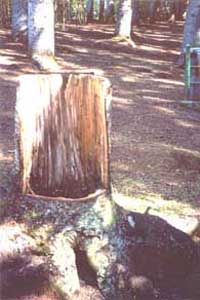
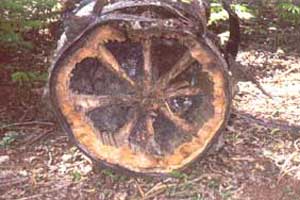
Tree stump and cut log
This photo was taken in the park on Wa’ahila Ridge. Ground
termites are fond of Norfolk Island pines and they infest the centers
but do not break through the bark. In this case they ate right up
to the outer rim of the tree. The tree was weakened considerably
so that when a strong wind came along it fell over. Note that in
the photo of the cut log that was several feet up from the stump,
the termites did not eat the parts of the tree branches where they
travel horizontally through the trunk of the tree and join the center
section. This is not an uncommon occurrence and they have fallen
into houses and cars. This is not a good tree to plant in your yard.
The danger in having an infested tree in your
yard it that ground termites can travel through the roots. If the
roots go under the foundation of the house it is a subway that can
lead them in. Because they are inside the root and afforded its
protection they can be very difficult to control.

Aerial nest of ground termites
This photo was taken of an aerial nest of ground termites on a high-rise
building in Honolulu. They had a large nest under the roofing material
and had traveled down eight floors eating up eight successive bathrooms
as they went.
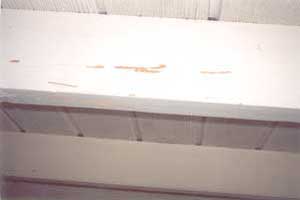
Ground termite flight slits
Termites are social insects and all the termites in one
colony are brothers and sisters having been born from one mother.
To start new colonies they must leave the nest and find a partner.
This is done every Spring as described earlier. To facilitate the
swarmers getting out of the nest the workers will create flight
slits in the wood then fill the slits with mud until the moment
the swarmers are ready. Then they open the slits and stick their
noses out. If there is no wind they launch by the thousands. If
it is windy they close the slits up and wait for better conditions.
If the termites are inside a wall they will eat through the sheetrock
or other material to allow the swarmers to escape. Generally, the
flight slits are several feet high to aid the swarmers in becoming
airborne. They are poor flyers and with wings more than twice the
size of their bodies it is better described as fluttering. I watched
them swarm from a bamboo stump that barely protruded from the ground
and it was surrounded by dozens of toads of all sizes that practically
inhaled the termites as they emerged.
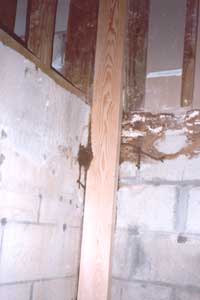
Hollow tile retaining walls
Houses built on hillsides with retaining walls have always
been a problem for several reasons. More often than not, the soil
that was back-filled against the wall was not treated with liquid
insecticide. Once the wall was in place it was difficult or impossible
to treat the soil and stop the termites once they infested. Ground
termites are able to dissolve the lime mortar used to hole the tile
together so they can come right through the wall. Very often these
walls are in a place that is not easy to get to or may be covered
with sheetrock so there is no easy way to inspect them.
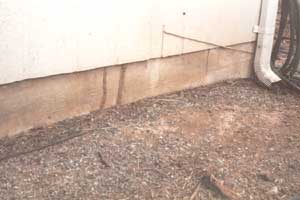
Termites entering over the edge of
the slab
This is one of the most frequent ways termites enter a
house with this type of construction. They are much more inclined
to enter this way if the siding is closer to the soil but they have
nothing to deter them.
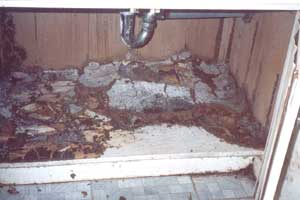
Termites entering around the plumbing
Where pipes and drains penetrate the concrete slab ground
termites will enter as well. Often there is a leak and that precipitates
the infestation. This house had two bathrooms side-by-side and termites
entered through the drain in one bathroom and spread to the adjoining
one doing considerable damage.
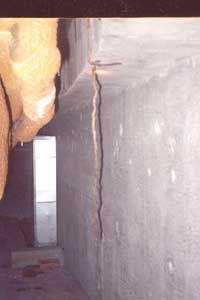
Free-standing tube
This photo was taken under the pool of a penthouse condominium.
Ground termites had established an aerial nest on the pool deck
and were working their way down looking for more food. This tube
was approximately two and a half feet long and was suspended from
the pool deck above. When I discovered it there were still termites
inside of it building their way down. I have found similar tubes
being built from the ground up under houses in their pursuit of
additional food sources.
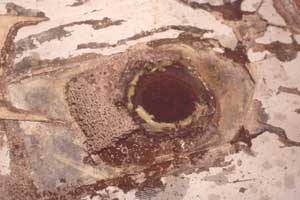
Ground termites enter through
a broken toilet drain pipe
On three occasions I have found ground termites entering
houses, or in this case a hotel, through the toilet drain pipe.
The pipe has broken somewhere underground and termites entered it
probably for the moisture it provided. They then built a mud tube
inside the pipe to where the toilet is anchored to the floor. They
then dissolve the wax seal between the toilet and the floor and
travel under the floor covering, usually linoleum, to reach framing
lumber or cabinets. This method of infesting the house is difficult
to detect and can only be remedied by repairing the broken drain
which may involve breaking the concrete slab.
Back to Top
|















